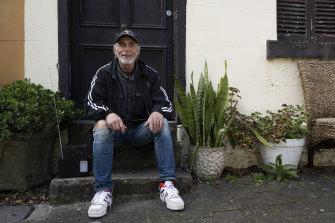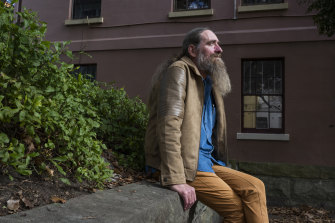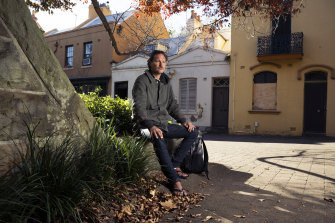- Exclusive
- National
- NSW
- Homelessness
Rough sleeping on the rise: Why Dave chose to return to the streets
When the COVID-19 pandemic hit in March 2020, Dave* was sleeping in the sandstone cave at Mrs Macquarie’s Chair.
But like many other rough sleepers, he was temporarily housed in a city hotel at taxpayers’ expense.
The hotel program was part of a NSW government push to get people off the streets to stop the spread of the virus. It was coupled with the Together Home program, which started in June 2020 with the aim to move people from homelessness to long-term accommodation.

Dave, 58, is sleeping in a hostel but happier outdoors.Credit:Louise Kennerley
Dave never got that far. The 58-year-old stayed in the hotel for six weeks before packing up and voluntarily moving back to the streets.
“At first they were happy to put everyone up, but they started to want more of me,” Dave said, speaking to The Sun-Herald at the Hope Street Cafe in Woolloomooloo.
“They were beginning to be reluctant and I said to them, ‘I didn’t want to be inside in the first place, I did this for the police’. We had just locked down for the first time in history all over the world, and I went inside to get out of the way.”
The annual statewide rough sleeping street count in February found 1207 people sleeping outdoors, the most visible form of homelessness. This was a fall overall, but there were regional rises including on the South Coast, Mid North Coast and Coffs Harbour.
A spokesperson for the Department of Communities and Justice said the $122.1 million Together Home program had helped 776 people with housing needs so far, but did not provide figures on how many placements were successful.
The department is expected to spend more than $1 billion this financial year on homelessness and social and affordable housing programs.

John Parsons, senior case worker at BaptistCare’s Hope Street service in Woolloomooloo.Credit:Louise Kennerley
Despite these efforts, service providers say rough sleeping is on track to be worse than it was before the pandemic.
The City of Sydney found 225 people sleeping rough within the CBD and surrounds in February, compared with 275 the previous year.
Yet John Parsons, senior caseworker at BaptistCare’s Hope Street service in Woolloomooloo, said he was serving just as many rough sleepers as before the pandemic, about an equal share of old faces and new.
Parsons said the pandemic showed that housing homeless people “can be done” but policies had now snapped back to normal, including tighter restrictions on temporary accommodation, a focus on compliance for social housing, and Centrelink cutting off benefits if people could not prove they were searching for work.
Jo Mills, practice lead for youth and homelessness at Uniting, said she expected the numbers of rough sleepers would soon be as high, “if not higher”, than before the pandemic because service providers were seeing a new type of client.
Mills said Sydneysiders moving to the regions had pushed working families and other people on low incomes out of the private rental market. Mills said the crisis was particularly bad on the Central Coast because it was a commuting distance to Sydney.
“There are people who literally cannot find housing for the first time in their lives, and have joined that group of rough sleepers - families camping in tents or camping in cars that perhaps have never done this before,” Mills said.
Parsons estimated one in four Together Home participants from his patch had returned to the streets.
“There are little levels of things you’ve got to provide [to] providers to have the opportunity to move into your own accommodation,” Parsons said. “A lot of them baulked at that and have chosen to come back out.”
In some cases it has been involuntary. Kai, 39, was housed in a “beautiful” studio apartment in Dee Why through Together Home, for several months in 2020.
Then he was sent to prison, for a crime he says he did not commit. When he came out, his accommodation was cancelled, and he moved onto the streets.
Kai has recently returned from Melbourne and has been sleeping under the rail bridge near the Hope Street Cafe in Woolloomooloo for the past few weeks, coping with the cold snap with “lots of blankets”.

Kai, 39, is sleeping under the rail bridge in Woolloomooloo.Credit:Louise Kennerley
Kai said he was “just passing through”.
“I thought it best to come to a place where there’s food, there’s generous people, there’s resilient people, there’s very much a community down here,” he said.
Meanwhile, Dave was committed to a mental hospital after returning to the streets. He was told he has schizophrenia - a diagnosis he disputes - and released to stay in a hostel in Surry Hills.
Dave said the room at the hostel was clean and comfortable, but a waste of his money (the cost comes out of his Centrelink benefits) given he would prefer to sleep outside.
Mills said most people preferred not to sleep outside, especially in winter, but might not bother to apply for temporary accommodation if it was only to get housing for a few nights.
“It’s not that they choose to stay rough sleeping, but they choose not to have to fight their way through the system, one or two days at a time,” Mills said.
Mills said Together Home had helped some people secure housing, but it was only a small part of the picture. The main pot of homelessness funding, the specialist homelessness services for crisis and temporary accommodation, had not increased.
* The Sun-Herald has chosen not to use surnames for Dave and Kai.
Link2Home 1800 152 152 – Available 24 hours, 7 days a week
The Morning Edition newsletter is our guide to the day’s most important and interesting stories, analysis and insights. Sign up here.